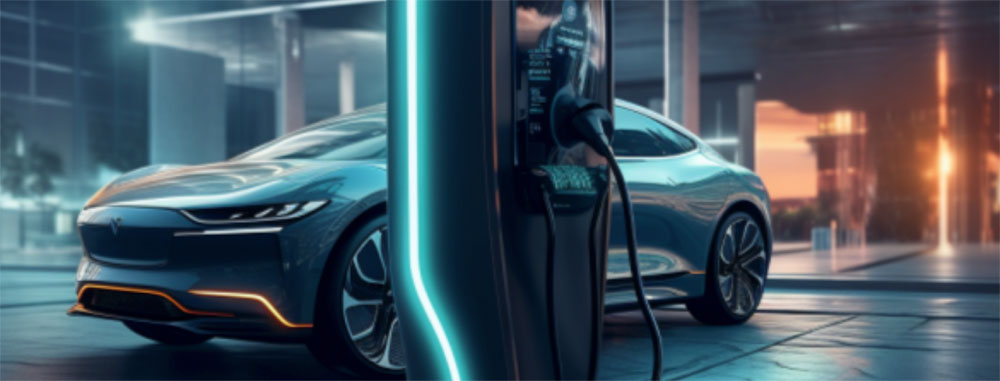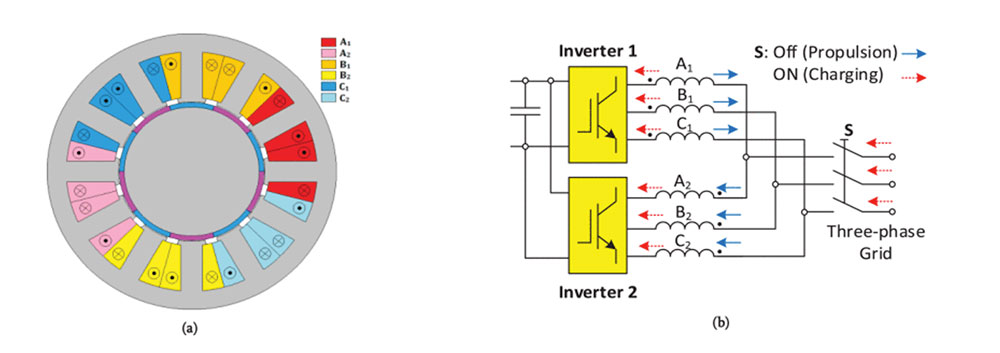Review of Integrated On-Board Battery Chargers

Overview: This article reviews electric vehicle battery charger technology, including the advantages and disadvantages of integrated on-board battery chargers. It also discusses the concept of fractional slots with concentrated windings.
According to estimates of the automotive market, by 2030, electric vehicles will account for around 30% of the market. The development of batteries has a major impact on the growth of electric vehicles.
What Factors Hinder the Growth of the Electric Vehicle Industry?
Important obstacles to commercialization are the electric vehicle battery's lifetime, charging time, weight, and cost. In addition to material and electrochemistry issues, other things that affect the performance of a battery module are its electrical charging and discharging characteristics, its design, and how it is packaged.
The length of time needed to charge a battery, its lifespan, and the features of the battery charger being used are all significantly correlated.
Classification of Electric Vehicle Battery Charger
Generally speaking, electric vehicle battery chargers fall into two categories: off-board and on-board, and they can have either unidirectional or bidirectional power flow capability.
- Unidirectional charging reduces hardware needs and complexity in grid connectivity, which are the two benefits.
- Bidirectional charging, however, enables the infusion of battery power back into the grid.
- Off-board chargers provide increased power transfer capabilities at a greater infrastructure cost. They are deployed at special charging stations.
- On-board charging systems are capable of making direct connections to single-phase or three-phase mains, which eliminates infrastructure costs. However, a number of limitations or trade-offs, including the vehicle's weight, volume, and cost, usually limit the ability to transfer power.
Integrated On-Board Battery Chargers
Separate charging circuits with large add-on inductors are used in on-board battery chargers. So-called "integrated on-board battery chargers" get around the problems with on-board battery chargers while keeping their benefits.
They do this by charging the batteries using the electric motor and inverter, which are already part of the propulsion circuit, instead of a separate charging circuit. The motor windings serve as galvanic isolation or filter inductances.
The propulsion inverter, on the other hand, serves as a bidirectional DC/AC converter. Recently, this technology has come to light as an ideal solution between off-board and on-board battery chargers.
For this technique to work, it needs to meet certain technical requirements during the charging process, such as
- Little to no winding reconfiguration
- Zero average torque or torque ripple
In order to achieve these requirements, the following factors play an important role:
- Motor types
- Number of phases
- Power converter
Types of Electric Motor
Different types of electric motors are used in electric vehicles:
- Induction motors (IMs)
- Switched-reluctance motors (SRM)
- Permanent magnet machines (PM)
Induction Motors
However, the majority of integrated onboard chargers described in the literature were built using induction motors that had traditional distributed windings.
Benefits
- Low cost
- Resilience
- Reliability
- Fewer maintenance needs
Switched-Reluctance Motors
As an integrated on-board charger machine candidate, switched-reluctance motors can make zero average torque while charging and can adjust the flow of energy in electric vehicle applications.
Benefits
- High-performing
- Reasonably priced
- The torque ripple is significant
- Large speed range
The key reasons for the sustained interest in switched-reluctance motors are their high starting torque and fault tolerance.
Permanent Magnet Machines
Based on an analysis of battery electric vehicles, the PMSM is currently the most widely used type of battery electric vehicle. However, out of all the other electric vehicle drivelines, PMSMs have the best efficiency.
Number of Phases
Three Phase Machines in Integrated On-Board Charger
While commercial installations indicate that the three-phase machine is the favored option for propulsion, there are other factors to take into account when thinking about an integrated onboard charger.
The three-phase machine needs extra parts that are not built in during the three-phase fast charging process to balance out the average torque that the three-phase currents produce as they flow through the machine windings.
For single-phase, slow-integrated on-board chargers, standard three-phase machines might work well. Because of these limitations and the problems with three-phase machines in integrated on-board chargers that have already been mentioned, multiphase machines have gotten a lot of attention.
Multiphase Machines in Integrated On-Board Charger
In many aspects, multiphase machines are superior to their three-phase equivalents. By distributing the power over more phases, the converter rating per phase is decreased while providing increased fault tolerance.
Benefits
By making use of the additional degrees of freedom that multiphase machines offer, multiphase machines in electric vehicle drivetrains can efficiently ensure zero torque production throughout the charging phase. This makes integrated on-board chargers for electric vehicle applications feasible.
Drawbacks
Even with the aforementioned benefits, multiphase machines require a more sophisticated controller and inverter. Furthermore, compared to their three-phase equivalents, the decoupling transformations used in multiphase systems are highly complex.
The Concept of Fractional Slot Concentrated Winding (FSCW)
High-speed motors with mechanical gear were used in early electric and hybrid vehicles to lower engine speed and transfer motor power to the wheels.
In order to prevent friction losses and preserve maximum torque capabilities, low-speed in-wheel-motor constructions have been used in recent designs. In this case, the fractional slot concentrated winding layout is a good alternative to a distributed winding (DW) for reaching this goal.
The fractional slot concentrated winding offers a slot fill factor of about 78% when used with segmented stator designs. It also cuts down on end-turn length and speeds up production. These benefits lead to a possible economical solution.
New research shows that the way multiphase fractional slot concentrated winding layouts are built in PM machines has a big impact on how well they can weaken flux and handle faults.
Permanent Magnet Machines with an FSCW
Permanent magnet machines with an FSCW, as shown in Fig. 1, provided
- High torque density
- High efficiency
- Low cogging torque
- Flux-weakening capabilities
- Fault tolerance

Fig. 1. Integrated on-board battery charger utilizing PM machine with FSCW Source: IEEE Access
However, in the air gap, the FSCW frequently results in non-uniform flux density patterns. Space harmonics that are not synchronous and have pretty high magnitudes, such as sub and super harmonics, cause eddy currents in the core of the rotor. These cause the rotor to lose a lot of power. Despite being less than stator losses, these losses have a significant impact on machine performance.
The rotor magnets become overheated due to inadequate ventilation, which inevitably results in thermal demagnetization. The choice of slot/pole combination has a big effect on the noise and unwanted vibrations that happen in the structure because of these non-synchronous low-order harmonics interacting with each other.
Numerous interesting combinations of stator slots and poles have demonstrated potential for electric vehicle use. The main things that determine the best slot and pole combinations are the cogging torque, fill factor, rotor losses, and net radial forces. Some of them use FSCW windings that are not overlapped, and others use overlapped windings with a coil pitch of two.
When overlapped windings with a coil pitch of two are used, the air gap flux distribution is significantly enhanced, and the undesirable slot harmonics are significantly reduced.
Summarizing the Key Points
- The lifetime, charging time, weight, and cost of electric vehicle batteries are important obstacles to commercialization of electric vehicle industry.
- Electric vehicle battery chargers fall into two categories: on-board and off-board.
- Integrated on-board chargers are a type of on-board battery charger that charges the batteries using components of propulsion circuit, which are the electric motor and inverter.
- A battery charger's ability to meet specifications depends on a number of elements, including power converter, number of phases, and kind of motor.
- Fractional slot concentrated winding, which is low-speed in-wheel-motor construction, offers a slot fill factor of roughly 78%, reduces end turn length, and simplifies production.
Reference
Metwly, Mohamed Y., Mahmoud S. Abdel-Majeed, Ayman S. Abdel-Khalik, Ragi A. Hamdy, Mostafa S. Hamad, and Shehab Ahmed. “A Review of Integrated On-Board EV Battery Chargers: Advanced Topologies, Recent Developments and Optimal Selection of FSCW Slot/Pole Combination.” IEEE Access 8 (2020): 85216–42. https://doi.org/10.1109/access.2020.2992741.